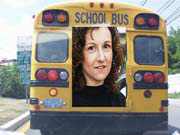Most people take for granted the ordinary things in life, such as going to the local supermarket or drug store, or ordering food for lunch.
For a handful of Secaucus High School students, practicing such tasks has allowed them to become more confident in the everyday world, and helped them make links with a community they might not otherwise have made.
Once a week, four special education students who suffer from various disabilities leave their classroom and the familiar school setting to venture into the wider world of local commerce, dealing with clerks and postal workers, bankers and druggists.
“Nearly everybody has been extremely nice to us,” said one of the students, a nearly constantly grinning girl whom a year ago teachers describe as somewhat depressed.
As part of a program to introduce special education students to the community, they travel on Fridays to the bank, the post office, and the dry cleaner. They often take orders for lunch for teachers from a local delicatessen.
Marra’s Drug Store in the Plaza is a regular stop, and so are the Acme supermarket and the Bagel Buffet.
“We even go to pick up things from UPS,” said another student. United Parcel Service has a service desk off County Avenue.
For these students, the trips provide them with the skills they will need later when they go out into the wider world .
Recently, the New Jersey School Board Association honored Secaucus with its Innovations in Special Education Award.
Helping kids help themselves
Nanci Valenti, who has been employed in the Secaucus school district since 1989, where she serves as a special education teacher and a speech therapist, thought up the idea last year. She initially thought to have the kids pick up her things from the dry cleaner or make a deposit in the bank.
“But then I thought, why should they just do this for me?” she said. “Why couldn’t they do it for all the teachers?”
When the program was proposed last year, she said the school needed to give the special education students exposure to the real world and practical experience with real-life situations.
Thus, a way improve their social skills, to transact business in a commercial situation, and to communicate with other people. The program allowed these students to make purchases, get change or order lunch. When Valenti first approached the students with the idea last year, their reaction was sharply negative.
“No way,” one of the students had said.
“It’s a stupid idea,” another had said.
“We’re not going to do it,” the third student had said.
“I told them, too bad, we’re going to do it anyway,” Valenti said.
But she needed to coach them. They had lots of questions about what to do and what not to do. They acted out situations at the school, such as going to the post office to order stamps.
“We rehearsed it all,” Valenti said. “What to ask. What the person’s answer would be.”
One important element in all this is the local businesses and their willingness to cooperate.
“Merchants are very positive, and that’s something I did not anticipate,” Valenti said.
By having the students go to the same places week after week, they developed relationships with sales people.
Getting a more varied look at the world
The students, rather than sitting in classrooms where stimuli largely remain unchanged throughout the day, go to places like the Mall at Mill Creek, where they experience colorful store displays and interact with other shoppers. By allowing these students to handle money and take responsibility for unique situations, they become more independent. Their skills become reinforced by the weekly repetition.
“They even advocate their likes and dislikes,” Valenti said. “Before we started this program, they used to sulk.”
These trips also provides the community with an education, showing clerks and other patrons how these kids can overcome their own disabilities to become contributing members of the community.
This is called community-based instruction and it features ongoing, routine, and thoroughly planned learning opportunities, allowing a connection to be made between skills learned in the classroom and the application of those competencies in “real life” situations. This real life instruction can be provided within the community where the student lives. The skills being applied in the community can help foster a successful transition into adulthood.
The four students were selected for the program by the school’s professionals, who evaluated their potential capabilities. Support comes from Arlene Broski, the head of the Child Study Team, and of course, Principal Pat Impreveduto, who allows the program to operate, encouraging teachers to cooperate and make orders.
The students say that Impreveduto sometimes orders tuna fish sandwiches for lunch.
Less than a year into the program, the biggest issue that the kids – who are freshmen and sophomores in high school – face is the politics of who gets to push the shopping cart.
While they will go to the Mill Creek Mall on occasions, they usually stay within the center of town. They have been asked to pick up things as odd as a fish tank. The program fits with their social studies curriculum as well as their speech and language therapy.
The students gets around by school bus. Valenti and the bus the driver, Richard Sabella, help the students get where they need to go.
For teachers and administrators back at the high school, there is a ritual is well. They have to have their forms in by midweek so the students can plan out their Friday route. No money on Friday, no service.
The students claim the bank is the hardest of their chores. On one trip to the dry cleaner, they had to pick up a ball gown. The post office, they say, is the easiest.
“The post office does everything for you,” a student said.
